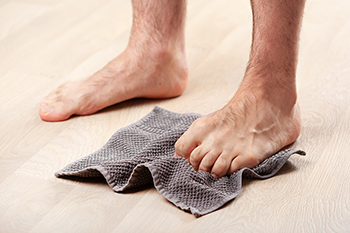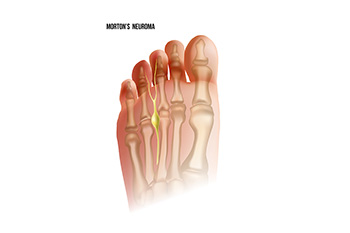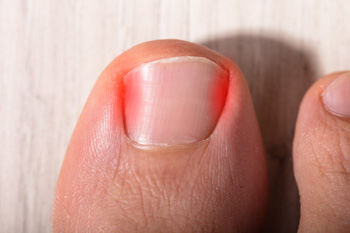Items filtered by date: February 2024
Common Signs of Peripheral Artery Disease in the Feet

Peripheral artery disease, or PAD, is a vascular condition characterized by narrowed arteries, limiting blood flow to the extremities. Recognizing the signs of PAD, particularly in the feet, is essential for early detection and treatment. One notable symptom is intermittent claudication, causing pain or cramping in the legs during physical activity. Reduced blood flow can result in coolness or numbness in the feet, along with weakened or absent pulses in the ankles and feet. Slow-healing wounds or sores, especially on the feet, may indicate compromised circulation. Changes in skin color, such as paleness or a bluish tint, could also be observed. Additionally, individuals with PAD may experience hair loss on their feet and legs, as well as shiny or thin skin. Ignoring these signs can lead to serious complications, including tissue damage and an increased risk of amputation. If you have PAD, and your feet are affected, it is suggested that you consult a podiatrist who can help you to manage this condition.
Peripheral artery disease can pose a serious risk to your health. It can increase the risk of stroke and heart attack. If you have symptoms of peripheral artery disease, consult with Kinna Patel, DPM from Sava Podiatry & Wellness Centers. Our doctor will assess your condition and provide you with quality foot and ankle treatment.
Peripheral artery disease (PAD) is when arteries are constricted due to plaque (fatty deposits) build-up. This results in less blood flow to the legs and other extremities. The main cause of PAD is atherosclerosis, in which plaque builds up in the arteries.
Symptoms
Symptoms of PAD include:
- Claudication (leg pain from walking)
- Numbness in legs
- Decrease in growth of leg hair and toenails
- Paleness of the skin
- Erectile dysfunction
- Sores and wounds on legs and feet that won’t heal
- Coldness in one leg
It is important to note that a majority of individuals never show any symptoms of PAD.
Diagnosis
While PAD occurs in the legs and arteries, Podiatrists can diagnose PAD. Podiatrists utilize a test called an ankle-brachial index (ABI). An ABI test compares blood pressure in your arm to you ankle to see if any abnormality occurs. Ultrasound and imaging devices may also be used.
Treatment
Fortunately, lifestyle changes such as maintaining a healthy diet, exercising, managing cholesterol and blood sugar levels, and quitting smoking, can all treat PAD. Medications that prevent clots from occurring can be prescribed. Finally, in some cases, surgery may be recommended.
If you have any questions, please feel free to contact our office located in Smyrna, GA . We offer the newest diagnostic and treatment technologies for all your foot care needs.
Exercises to Help Manage Plantar Fasciitis Pain

Experiencing the discomfort of plantar fasciitis should not keep you sidelined from the activities you enjoy. Along with professional guidance from a podiatrist, integrating targeted exercises into your daily routine can provide significant relief from the heel pain that accompanies this repetitive stress injury. Start with gentle stretches like the towel stretch, where you sit with legs extended, a towel wrapped around the ball of your foot, while pulling it towards you, and feeling the stretch along your calf and underfoot. Calf stretches, which are done by standing facing a wall with one foot behind the other and leaning forward, can help to alleviate tension in the calf muscles. Additionally, the plantar fascia and calf stretch, performed on a step with heels hanging off the edge, targets both the plantar fascia and calf muscles. For strengthening, try towel curls, scrunching a towel with your toes while seated, or marble pickups, using your toes to lift marbles and place them into a cup. With dedication and consistency, these exercises can play a vital role in managing plantar fasciitis and getting you back on your feet. Remember to start slowly, and gradual increase intensity. It is suggested you consult with your podiatrist before beginning any new exercise regimen.
Exercising your feet regularly with the proper foot wear is a great way to prevent injuries and build strength. If you have any concerns about your feet, contact Kinna Patel, DPM from Sava Podiatry & Wellness Centers. Our doctor can provide the care you need to keep you pain-free and on your feet.
Exercise for Your Feet
Exercise for your feet can help you gain strength, mobility and flexibility in your feet. They say that strengthening your feet can be just as rewarding as strengthening another part of the body. Your feet are very important, and we often forget about them in our daily tasks. But it is because of our feet that are we able to get going and do what we need to. For those of us fortunate enough to not have any foot problems, it is an important gesture to take care of them to ensure good health in the long run.
Some foot health exercises can include ankle pumps, tip-toeing, toe rises, lifting off the floor doing reps and sets, and flexing the toes. It is best to speak with Our doctor to determine an appropriate regimen for your needs. Everyone’s needs and bodies are different, and the activities required to maintain strength in the feet vary from individual to individual.
Once you get into a routine of doing regular exercise, you may notice a difference in your feet and how strong they may become.
If you have any questions please feel free to contact our office located in Smyrna, GA . We offer the newest diagnostic and treatment technologies for all your foot and ankle needs.
Common Symptoms of Morton’s Neuroma

Morton's neuroma is a painful condition that affects the ball of the foot, specifically the area between the third and fourth toes. This condition involves the thickening of the tissue surrounding a nerve leading to the toes, usually caused by irritation or compression. The hallmark symptom of Morton's neuroma is a sharp, burning pain or the sensation of a small, pebble-like object under the ball of the foot. As the condition progresses, individuals may experience numbness, tingling, or a feeling of swelling in the toes. The pain tends to worsen with activities like walking or wearing tight shoes, as these activities compress the affected nerve. Morton's neuroma is often more prevalent in women and individuals who frequently wear high heels or engage in activities that put repetitive pressure on the forefoot. Morton’s neuroma is treated by a podiatrist. If you are experiencing symptoms of this condition, it is suggested that you schedule an appointment with this type of doctor who can accurately diagnose and treat Morton’s neuroma.
Morton’s neuroma is a very uncomfortable condition to live with. If you think you have Morton’s neuroma, contact Kinna Patel, DPM of Sava Podiatry & Wellness Centers. Our doctor will attend to all of your foot care needs and answer any of your related questions.
Morton’s Neuroma
Morton's neuroma is a painful foot condition that commonly affects the areas between the second and third or third and fourth toe, although other areas of the foot are also susceptible. Morton’s neuroma is caused by an inflamed nerve in the foot that is being squeezed and aggravated by surrounding bones.
What Increases the Chances of Having Morton’s Neuroma?
- Ill-fitting high heels or shoes that add pressure to the toe or foot
- Jogging, running or any sport that involves constant impact to the foot
- Flat feet, bunions, and any other foot deformities
Morton’s neuroma is a very treatable condition. Orthotics and shoe inserts can often be used to alleviate the pain on the forefront of the feet. In more severe cases, corticosteroids can also be prescribed. In order to figure out the best treatment for your neuroma, it’s recommended to seek the care of a podiatrist who can diagnose your condition and provide different treatment options.
If you have any questions, please feel free to contact our office located in Smyrna, GA . We offer the newest diagnostic and treatment technologies for all your foot care needs.
Why Children Develop Ingrown Toenails
 Children and teens can experience ingrown toenails, a painful condition caused by the edge of a toenail growing into the surrounding skin. Signs of ingrown toenails can include toe pain, redness and pus emerging from the edge of the toenail, and tenderness while walking. Common causes of ingrown toenails in children include improper toenail trimming that leads to sharp edges which can penetrate the skin, or wearing tight shoes that puts pressure on the toes. Additionally, trauma to the toe, such as stubbing or dropping something on it, can lead to ingrown toenails. It is important for parents and caregivers to be mindful of how they trim their child's nails to prevent ingrown toenails and the infections they can cause. If a child experiences persistent discomfort or ingrown toenails that keep coming back, it is suggested you make an appointment with a podiatrist, who can help address the issue and prevent further complications.
Children and teens can experience ingrown toenails, a painful condition caused by the edge of a toenail growing into the surrounding skin. Signs of ingrown toenails can include toe pain, redness and pus emerging from the edge of the toenail, and tenderness while walking. Common causes of ingrown toenails in children include improper toenail trimming that leads to sharp edges which can penetrate the skin, or wearing tight shoes that puts pressure on the toes. Additionally, trauma to the toe, such as stubbing or dropping something on it, can lead to ingrown toenails. It is important for parents and caregivers to be mindful of how they trim their child's nails to prevent ingrown toenails and the infections they can cause. If a child experiences persistent discomfort or ingrown toenails that keep coming back, it is suggested you make an appointment with a podiatrist, who can help address the issue and prevent further complications.
Finding a properly-fitting shoe is important in reducing injuries and preventing foot problems. For more information about treatment, contact Kinna Patel, DPM from Sava Podiatry & Wellness Centers. Our doctor will treat your foot and ankle needs.
Proper Shoe Fitting
A common concern when it comes to foot health, having properly fitted shoes can help prevent injuries to the foot. Out feet affect our posture and gait, which in turn affects the biomechanics and overall bodily structure. With 33 joints, 26 bones, and over 100 ligaments, the potential for serious injury is much greater than one realizes. Although the feet cease growth in adulthood, they still change shape as they mature. Here are some factors to consider when it comes to investing in proper fitting shoes:
- Be sure the shoes fit correctly right away
- Ensure the ball of your foot fits comfortably in the widest portion of the shoes
- Even though they may look fashionable, improper fitting shoes can either create adverse conditions or exacerbate existing ones you may already have
- Walk along a carpeted surface to ensure the shoes comfortably fit during normal activity
Keeping in mind how shoes fit the biomechanics of your body, properly-fitting shoes are vitally important. Fortunately, it is not difficult to acquire footwear that fits correctly. Be sure to wear shoes that support the overall structure of your body. Do your feet a favor and invest in several pairs of well-fitted shoes today.
If you have any questions please feel free to contact our office located in Smyrna, GA . We offer the newest diagnostic and treatment technologies for all your foot and ankle needs.









